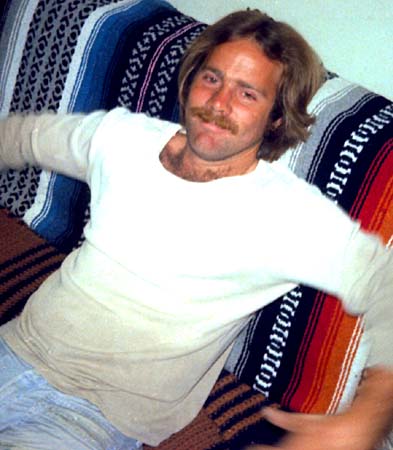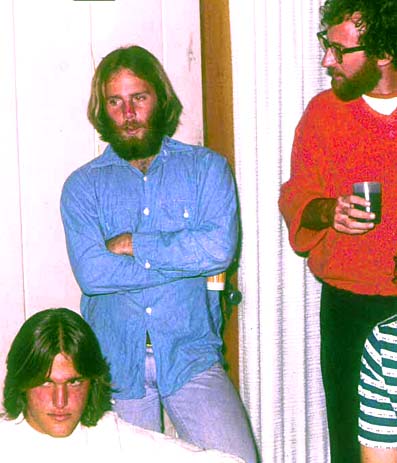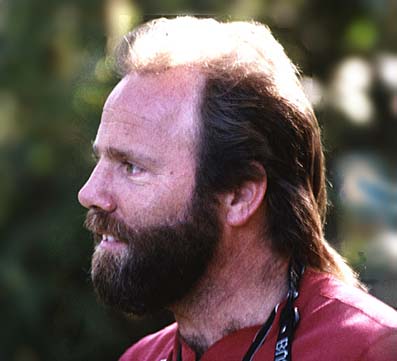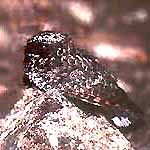 Kimball
Garrett is one of southern California's most accomplished birders. He,
like his friend Jon Dunn, grew up in Los Angeles and was birding at an
early age. He first appears in the southern California region of American
Birds in spring 1970 (under the name Kim Garrett; a Virgina's Warbler
in Hollywood on 20 May). Although Kimball attended U.C. Berkeley for a
time, he has otherwise remained in the Los Angeles area. He is now the
foremost authority on the birds of Los Angeles County, and has the highest
county list. Since 1982 he has been the ornithology collections manager
at Los Angeles Natural History Museum. Kimball
Garrett is one of southern California's most accomplished birders. He,
like his friend Jon Dunn, grew up in Los Angeles and was birding at an
early age. He first appears in the southern California region of American
Birds in spring 1970 (under the name Kim Garrett; a Virgina's Warbler
in Hollywood on 20 May). Although Kimball attended U.C. Berkeley for a
time, he has otherwise remained in the Los Angeles area. He is now the
foremost authority on the birds of Los Angeles County, and has the highest
county list. Since 1982 he has been the ornithology collections manager
at Los Angeles Natural History Museum.
Kimball has been known as a sharp field birder since his early days. Stories of his "legendary ears" are, well, the stuff of legend [i.e., his ability to pick out and i.d. distant bird calls]. That acute hearing was a significant asset to the record-setting Big Day team on 29 Apr 1978 [with J.L. Dunn, J.V. Remsen, and R.E. Webster]. Their 231 species remains the non-airplane California record. Kimball is exceptionally well known for his work as co-author (with Jon Dunn) of two major books: the Birds of Southern California (1981), published by the Los Angeles Audubon Society but now an out-of-print classic, and the Field Guide to Warblers of North America, published in the Peterson series in 1997 (after the close of our period of review). The latter is considered the definitive work on that identification topic. Throughout the '70s and '80s, Kimball authored a series of identification papers in the Western Tanager, the LAAS newsletter, and published widely read i.d. papers in Birding magazine (e.g., Dunn & Garrett 1990, Dunn et al. 1995). It seems like Kimball has done just about everything one can do for the Los Angeles Audubon Society; he is a frequent author in the newsletter, editing the seasonal records for years, lead field trips, been their premier speaker, organized Christmas Bird Counts, and much more. Kimball has also had a major impact on the California Bird Records Committee. He served as a member for 11 of the 12 years between 1978-1989, sitting out one year as required by the bylaws, but continues to be a presence there to this day. Kimball has also long been the Los Angeles County subregional editor for American Birds but, since the close of our period, has become the co-editor (with Guy McCaskie) for the entire Southern Pacific Coast region. Photo (above) at the Big Day celebration party at Kimball's
apartment in Westwood, L.A., 30Apr 1978 © Barry Clark
|
|
Kimball may be the most clever writer I know. He doesn't allow this
to spill over into his published scientific papers, but otherwise a cleverly
devious line may appear anywhere. There are several in the tongue-in-cheek
classic "In search of the Ringed Turtle-Dove" that he wrote with Van Remsen
in 1976, just in time for an ABA convention in southern California. I recall
a time when we both were on the CBRC. I had heatedly argued for some position
in the previous round of voting. In the next round, Kimball began to deal
with my poubt this way — "With typical hyperbole, Roberson says that .
. ." — and destroyed my pitch in his opening phrase.

The best examples are his birder parodies on classic rock-and-roll songs. Kimball plays the guitar and sings, but it is the clever lines that one recalls decades later. Here is a snippet to the tune of Jimmy Buffet's Margaritaville (1977):
If you remember Peter Alden's (1969) book Finding the Birds in Western Mexico, then you are older than you look. More timeless is Kimball's classic, sung to The Eagles' Hotel California (1976): "Birder's California." The only clue you need is that the movie "Ten," with Bo Derek, was a hit just before this parody was written. Using the same concept, a "nine" is one hot bird! [in birder lingo, a "ten" would be a first record to science; a "nine" a first California record, etc.] Everything else you should understand, or you are not the hotshot birder you think you are: |
|

Photo (above right): Kimball hangs out at a birder party
in July 1976, with Fred Heath (upper right) and Louis Bevier (lower left)
© B.B. Roberson
|
|
| Kimball was given the name Poor-will, and although the naming committee
did not divulge reasons, perhaps this (apocryphal?) story provides a clue.
There was a year in the late 1970s when a lot of Horned Puffins were being
seen around the Channel Islands. Kimball was aboard a boat trip passing
right through the prime area, and for hours he whined that they'd probably
miss it. Then, outside of Santa Rosa Island, they saw their first Horned
Puffin of the trip. Kimball's reaction? "Geez, now we'll see them all day
and they'll get boring."
On the web site for the Los Angeles Natural History Museum, where Kimball is the Collections Manager, short vignettes about staff members are posted. The one about Kimball concludes with this happy thought: "Birds are Kimball's life; if he were to die happy, he would be out birding." nothing on this page has been made up
it is all strange but true |
|

Official Bird Name: Common Poorwill
Selected publications 1976-1989:
|